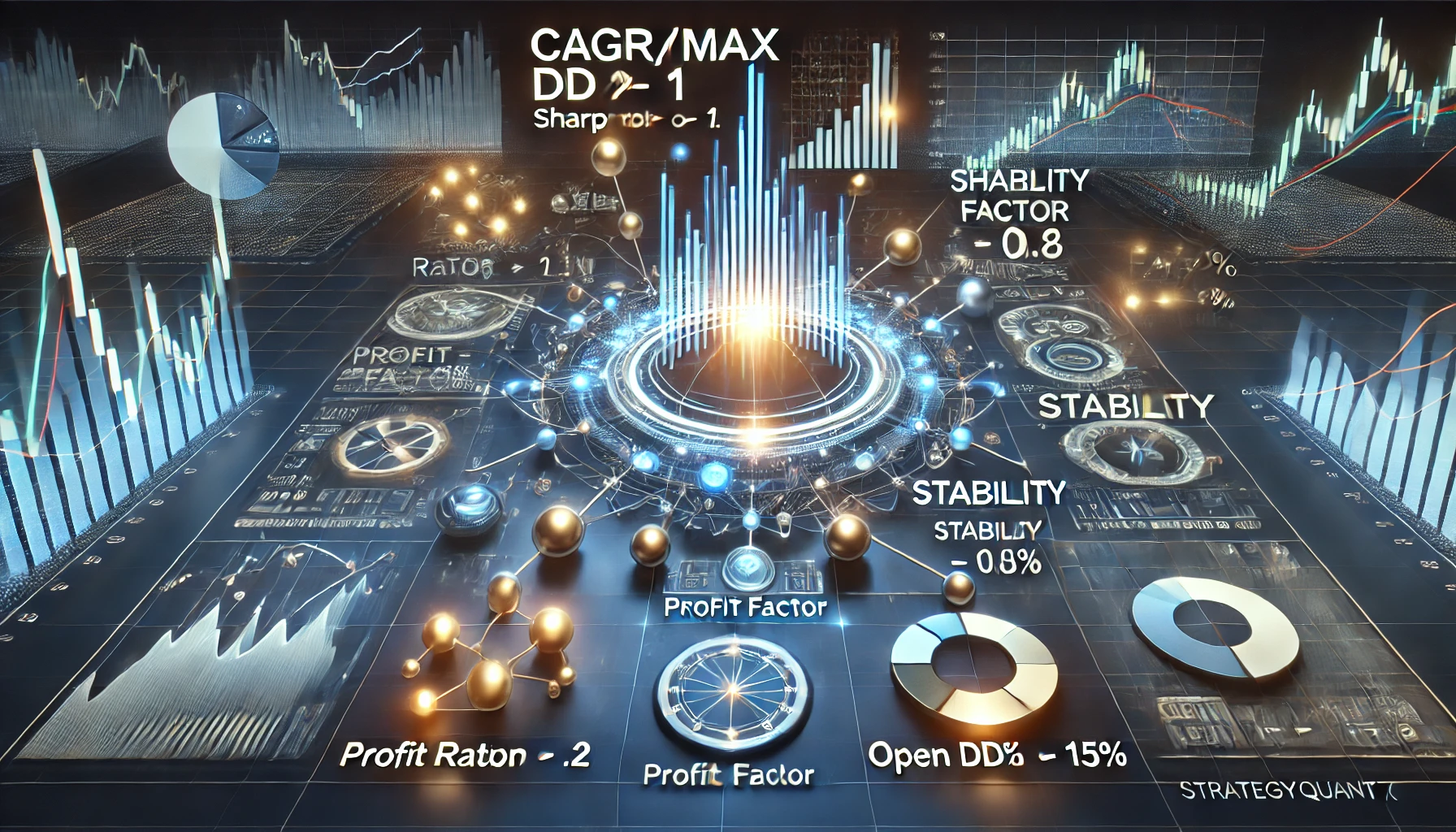Do you know all the filters / ranking (like profit factor, cagr/dd%, return/dd, ..) to mean profitable or good trend within SQX?
Yes, in StrategyQuant X (SQX), various performance metrics and ranking filters are used to assess whether a strategy is profitable and stable over time. Here’s a list of the most important metrics along with what they indicate and how they can be used for filtering/ranking:
Key Metrics for Evaluating Profitability and Stability
- Profit Factor
- What it measures: The ratio of gross profits to gross losses.
- Good value: A Profit Factor greater than 1.5 is generally considered good, with values over 2 indicating strong performance.
- Purpose: Filters out strategies that earn significantly more than they lose.
- CAGR/Max Drawdown % (Compounded Annual Growth Rate / Max Drawdown)
- What it measures: It compares the strategy’s annualized returns to the maximum drawdown (risk).
- Good value: A ratio greater than 1 is a positive indicator, meaning the returns are higher than the risk (drawdown).
- Purpose: Filters strategies that balance returns and risk effectively. Higher values indicate more sustainable growth relative to risk.
- Return/Drawdown Ratio (Ret/DD)
- What it measures: Another way to compare the strategy’s return against the drawdown.
- Good value: The higher, the better. Values above 2 are typically desirable.
- Purpose: Similar to CAGR/Max DD%, this shows how well the strategy performs against its worst losses.
- Sharpe Ratio
- What it measures: The Sharpe Ratio measures risk-adjusted returns, or how much excess return the strategy generates per unit of risk.
- Good value: A Sharpe Ratio above 1 is considered good, while above 2 is excellent.
- Purpose: Helps identify strategies that have consistent returns relative to risk.
- Stability
- What it measures: Measures the consistency of a strategy’s equity curve (how stable the growth is over time).
- Good value: A value greater than 0.8 is typically considered good.
- Purpose: Filters strategies that have steady performance without sharp fluctuations.
- Open Drawdown %
- What it measures: The percentage of drawdown that is still open (unrealized loss).
- Good value: Keeping Open DD% below 15% is often desirable.
- Purpose: Ensures that strategies don’t leave too much risk open during trades, keeping the drawdowns controlled.
- Max Drawdown %
- What it measures: The largest peak-to-valley loss in equity.
- Good value: Max DD% below 20% is usually acceptable for longer-term strategies, with lower being better for risk-averse traders.
- Purpose: Filters strategies that limit their risk exposure during downturns.
- Consecutive Win/Loss Trades
- What it measures: The maximum number of consecutive winning or losing trades.
- Good value: This metric is mostly a secondary consideration but can show streaks in winning or losing.
- Purpose: Can be used to avoid strategies that have long losing streaks.
- CAGR (Compounded Annual Growth Rate)
- What it measures: The annualized percentage growth of your account or equity curve.
- Good value: The higher the better, though it should be balanced with risk measures.
- Purpose: Shows the growth potential of the strategy.
- R-Squared (R²)
- What it measures: Shows the statistical fit of the strategy’s equity curve to a straight line. The closer to 1, the more stable the strategy’s growth.
- Good value: Above 0.8 is ideal for long-term stability.
- Purpose: Filters strategies with consistent upward growth.
- Kelly Criterion
- What it measures: Calculates the optimal position sizing based on past performance.
- Good value: A higher Kelly value indicates better risk-adjusted returns, but too high may suggest over-leveraging.
- Purpose: Guides sizing to maximize growth while managing risk.
- Net Profit
- What it measures: The total profit after deducting losses and costs.
- Good value: Positive and stable net profit over time is crucial, but it should be compared against risk metrics.
- Purpose: Ensures the strategy is actually making money.
- Sortino Ratio
- What it measures: Similar to the Sharpe Ratio but only considers downside risk (negative returns).
- Good value: A value above 1 is good, and higher values indicate better risk-adjusted performance focusing on negative volatility.
- Purpose: Helps focus on strategies that minimize downside volatility while delivering good returns.
Filtering Strategies in SQX
- Primary Filters:
- Sharpe Ratio > 2: Helps find strategies with good risk-adjusted returns.
- CAGR/Max DD% > 1: Ensures returns are higher than drawdowns.
- Profit Factor > 1.5: Ensures profits are sufficiently higher than losses.
- Secondary Filters:
- Open DD% < 15: Ensures drawdowns are within acceptable limits.
- Stability > 0.8: Ensures a smooth and steady equity curve.
- Other Considerations:
- Max Drawdown %: This is crucial for risk management, as it can help avoid strategies with sharp drawdowns.
- Return/Drawdown: Ensures that the strategy’s returns justify the risk it takes.
By using a combination of these filters, especially focusing on Sharpe Ratio, Stability, Profit Factor, and drawdowns, you can filter out strategies that are robust, profitable, and capable of performing well in live trading.





